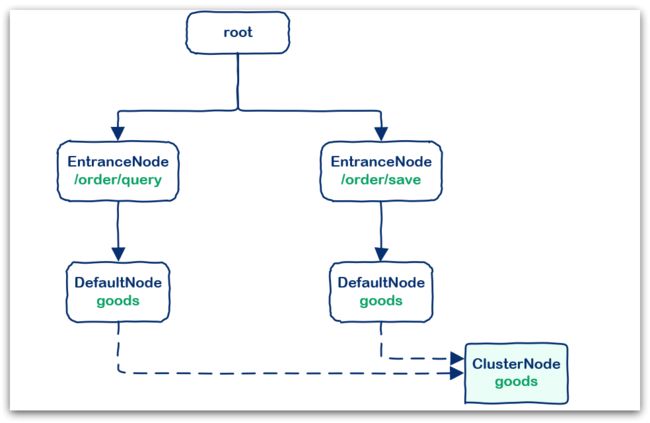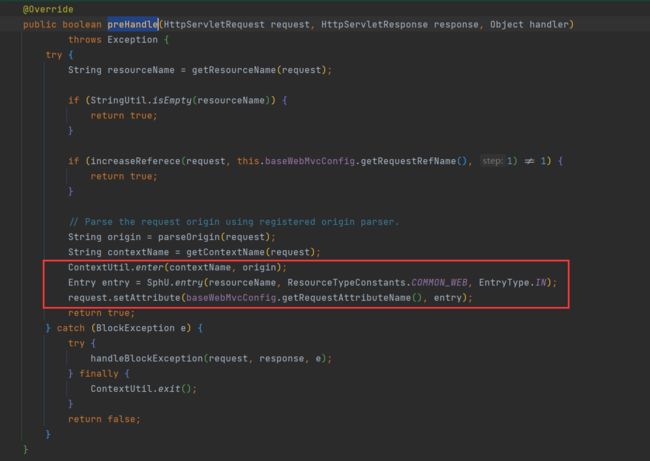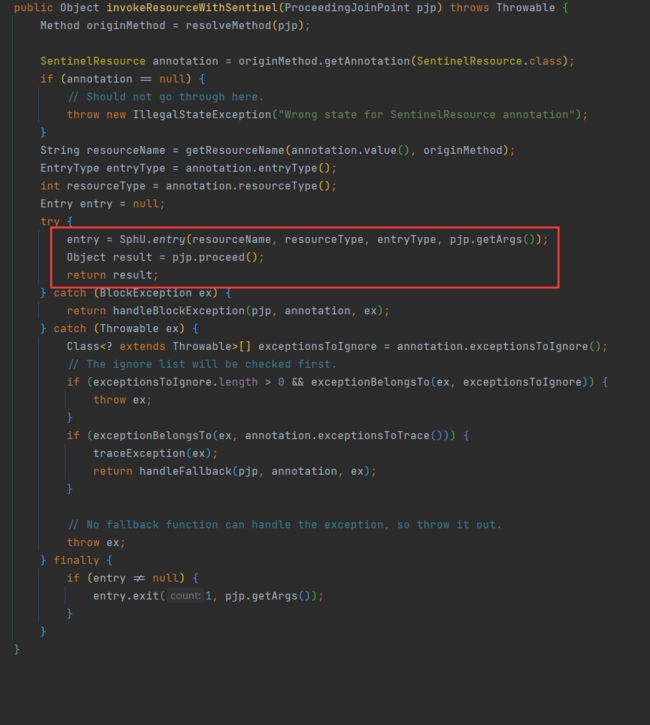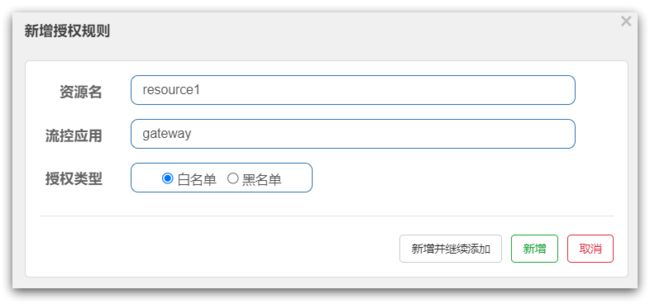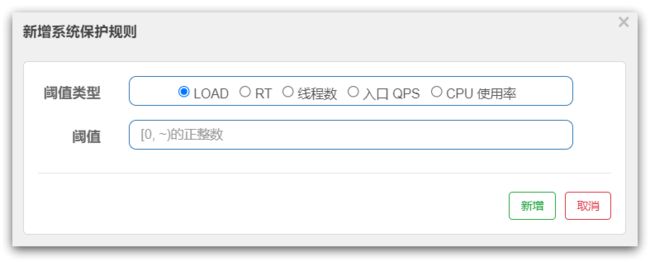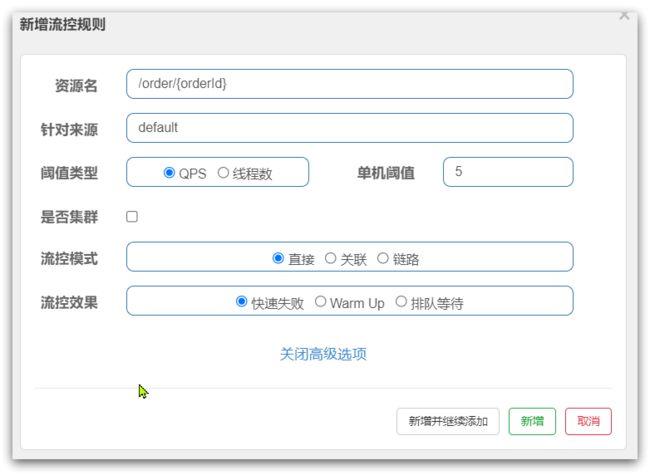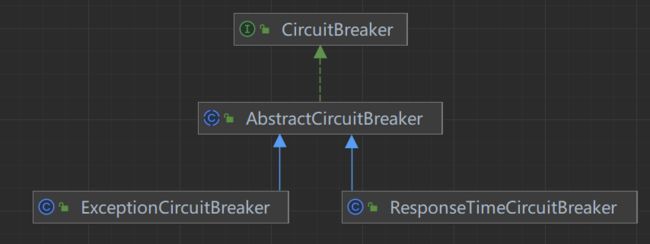【Sentinel】Sentinel原码分析
本文内容来自【黑马】Sentinel从使用到源码解读笔记,做了部分修改和补充
目录
Sentinel 基本概念
基本流程
Node
Entry
定义资源的两种方式
使用try-catch定义资源
使用注解标记资源
基于注解标记资源的实现原理
Context
什么是Context
Context的初始化
ContextUtil
ProcessorSlotChain执行流程
入口
NodeSelectorSlot
ClusterBuilderSlot
LogSlot
StatisticSlot
AuthoritySlot
SystemSlot
ParamFlowSlot
令牌桶
FlowSlot
滑动时间窗口
时间窗口请求量统计
滑动窗口QPS计算
DegradeSlot
触发断路器
Sentinel 基本概念
基本流程
在 Sentinel 里面,所有的资源都对应一个资源名称以及一个 Entry。Entry 可以通过对主流框架的适配自动创建,也可以通过注解的方式或调用 API 显式创建;每一个 Entry 创建的时候,同时也会创建一系列功能插槽(slot chain)。这些插槽有不同的职责:
NodeSelectorSlot负责收集资源的路径,并将这些资源的调用路径,以树状结构存储起来,用于根据调用路径来限流降级;ClusterBuilderSlot用于存储资源的统计信息以及调用者信息,例如该资源的 RT, QPS, thread count 等等,这些信息将用作为多维度限流,降级的依据;LogSlot用于响应日志记录块异常,以提供用于故障排除的具体日志;StatisticSlot用于记录、统计不同纬度的 runtime 指标监控信息;AuthoritySlot根据配置的黑白名单和调用来源信息,来做黑白名单控制;SystemSlot通过系统的状态,例如 load1 等,来控制总的入口流量;ParamFlowSlot负责通过频繁(“热点”)参数进行流控制的处理器插槽;FlowSlot则用于根据预设的限流规则以及前面 slot 统计的状态,来进行流量控制;DegradeSlot通过统计信息以及预设的规则,来做熔断降级;
总体的框架如下(旧版,未更新):
Sentinel 将 ProcessorSlot 作为 SPI 接口进行扩展(1.7.2 版本以前 SlotChainBuilder 作为 SPI),使得 Slot Chain 具备了扩展的能力。可以自行加入自定义的 slot 并编排 slot 间的顺序,从而可以给 Sentinel 添加自定义的功能。
Slot也为两大类:
- 统计数据构建部分(statistic)
-
- NodeSelectorSlot
- ClusterBuilderSlot
- LogSlot
- StatisticSlot
- 规则判断部分(rule checking)
-
- AuthoritySlot
- SystemSlot
- ParamFlowSlot
- FlowSlot
- DegradeSlot
Node
Sentinel中的簇点链路是由一个个的Node组成的,Node是一个接口,包括下面的实现:
所有的节点都可以记录对资源的访问统计数据,所以都是StatisticNode的子类。
按照作用分为两类Node:
DefaultNode:代表链路树中的每一个资源,一个资源出现在不同链路中时,会创建不同的DefaultNode节点。而树的入口节点叫EntranceNode,是一种特殊的DefaultNodeClusterNode:代表资源,一个资源不管出现在多少链路中,只会有一个ClusterNode。记录的是当前资源被访问的所有统计数据之和。
DefaultNode记录的是资源在当前链路中的访问数据,用来实现基于链路模式的限流规则。
ClusterNode记录的是资源在所有链路中的访问数据,实现默认模式、关联模式的限流规则。
例如:在一个SpringMVC项目中,有两个业务:
- 业务1:controller中的资源/order/query访问了service中的资源/goods
- 业务2:controller中的资源/order/save访问了service中的资源/goods
创建的链路图如下:
Entry
默认情况下,Sentinel会将controller中的方法作为被保护资源,如果想定义自己的资源,则需显示定义。
Sentinel中的资源用Entry来表示。
定义资源的两种方式
使用try-catch定义资源
// 资源名可使用任意有业务语义的字符串,比如方法名、接口名或其它可唯一标识的字符串。
try (Entry entry = SphU.entry("resourceName")) {
// 被保护的业务逻辑
// do something here...
} catch (BlockException ex) {
// 资源访问阻止,被限流或被降级
// 在此处进行相应的处理操作
}public Order queryOrderById(Long orderId) {
// 创建Entry,标记资源,资源名为resource1
try (Entry entry = SphU.entry("resource1")) {
// 1.查询订单,这里是假数据
Order order = Order.build(101L, 4999L, "小米 MIX4", 1, 1L, null);
// 2.查询用户,基于Feign的远程调用
User user = userClient.findById(order.getUserId());
// 3.设置
order.setUser(user);
// 4.返回
return order;
}catch (BlockException e){
log.error("被限流或降级", e);
return null;
}
}使用注解标记资源
@SentinelResource("orderResource")
public Order queryOrderById(Long orderId) {
// 1.查询订单
Order order = orderMapper.findById(orderId);
// 2.用Feign远程调用
User user = userClient.findById(order.getUserId());
// 3.封装user到Order
order.setUser(user);
// 4.返回
return order;
}基于注解标记资源的实现原理
Sentinel的stater中,spring.factories声明需要就是自动装配的配置类
在SentinelAutoConfiguration类中声明了一个SentinelResourceAspectbean
在SentinelResourceAspect中基于AOP实现了增强。
@Aspect
public class SentinelResourceAspect extends AbstractSentinelAspectSupport {
// 切点是添加了 @SentinelResource注解的类
@Pointcut("@annotation(com.alibaba.csp.sentinel.annotation.SentinelResource)")
public void sentinelResourceAnnotationPointcut() {
}
// 环绕增强
@Around("sentinelResourceAnnotationPointcut()")
public Object invokeResourceWithSentinel(ProceedingJoinPoint pjp) throws Throwable {
// 获取受保护的方法
Method originMethod = resolveMethod(pjp);
// 获取 @SentinelResource注解
// @SentinelResource("resource1")
SentinelResource annotation = originMethod.getAnnotation(SentinelResource.class);
if (annotation == null) {
// Should not go through here.
throw new IllegalStateException("Wrong state for SentinelResource annotation");
}
// 获取注解上的资源名称
String resourceName = getResourceName(annotation.value(), originMethod);
EntryType entryType = annotation.entryType();
int resourceType = annotation.resourceType();
Entry entry = null;
try {
// 创建资源 Entry
entry = SphU.entry(resourceName, resourceType, entryType, pjp.getArgs());
// 执行受保护的方法
Object result = pjp.proceed();
return result;
} catch (BlockException ex) {
return handleBlockException(pjp, annotation, ex);
} catch (Throwable ex) {
Class[] exceptionsToIgnore = annotation.exceptionsToIgnore();
// The ignore list will be checked first.
if (exceptionsToIgnore.length > 0 && exceptionBelongsTo(ex, exceptionsToIgnore)) {
throw ex;
}
if (exceptionBelongsTo(ex, annotation.exceptionsToTrace())) {
traceException(ex);
return handleFallback(pjp, annotation, ex);
}
// No fallback function can handle the exception, so throw it out.
throw ex;
} finally {
if (entry != null) {
entry.exit(1, pjp.getArgs());
}
}
}
}@SentinelResource注解就是一个标记,而Sentinel基于AOP思想,对被标记的方法做环绕增强,完成资源(Entry)的创建。
Context
在上面的簇点链路中除了controller方法、service方法两个资源外,还多了一个默认的入口节点:
sentinel_spring_web_context,这是一个EntranceNode类型的节点。
这个节点是在初始化Context的时候由Sentinel创建的。
什么是Context
- Context 代表调用链路上下文,贯穿一次调用链路中的所有资源(
Entry),基于ThreadLocal。 - Context 维持着入口节点(
entranceNode)、本次调用链路的curNode(当前资源节点)、调用来源(origin)等信息。 - 后续的Slot都可以通过
Context拿到DefaultNode或者ClusterNode,从而获取统计数据,完成规则判断 Context初始化的过程中,会创建EntranceNode,contextName就是EntranceNode的名称
对应的API如下:
// 创建context,包含两个参数:context名称、 来源名称
ContextUtil.enter("contextName", "originName");Context的初始化
在SentinelWebAutoConfiguration中,添加了SentinelWebInterceptor
@Autowired
private Optional sentinelWebInterceptorOptional;
@Override
public void addInterceptors(InterceptorRegistry registry) {
if (!sentinelWebInterceptorOptional.isPresent()) {
return;
}
SentinelProperties.Filter filterConfig = properties.getFilter();
// 添加一个SentinelWebInterceptor拦截器
registry.addInterceptor(sentinelWebInterceptorOptional.get())
.order(filterConfig.getOrder())
.addPathPatterns(filterConfig.getUrlPatterns());
log.info(
"[Sentinel Starter] register SentinelWebInterceptor with urlPatterns: {}.",
filterConfig.getUrlPatterns());
} SentinelWebInterceptor继承自AbstractSentinelInterceptor,而AbstractSentinelInterceptor实现了HandlerInterceptor接口,会拦截一切进入controller的方法,执行preHandle前置拦截方法,而Context的初始化就是在这里完成的。
@Override
public boolean preHandle(HttpServletRequest request, HttpServletResponse response, Object handler)
throws Exception {
try {
// 获取资源名称,一般是controller方法的@RequestMapping路径,例如/order/{orderId}
String resourceName = getResourceName(request);
if (StringUtil.isEmpty(resourceName)) {
return true;
}
if (increaseReferece(request, this.baseWebMvcConfig.getRequestRefName(), 1) != 1) {
return true;
}
// Parse the request origin using registered origin parser.
// 从request中获取请求来源,将来做 授权规则 判断时会用
String origin = parseOrigin(request);
// 获取 contextName,默认是sentinel_spring_web_context
String contextName = getContextName(request);
// 创建 Context
ContextUtil.enter(contextName, origin);
// 创建资源,名称就是当前请求的controller方法的映射路径
Entry entry = SphU.entry(resourceName, ResourceTypeConstants.COMMON_WEB, EntryType.IN);
request.setAttribute(baseWebMvcConfig.getRequestAttributeName(), entry);
return true;
} catch (BlockException e) {
try {
handleBlockException(request, response, e);
} finally {
ContextUtil.exit();
}
return false;
}
}如果要关闭使用sentinel_spring_web_context作为默认的root,只需要在application.yml文件中关闭即可
spring:
cloud:
sentinel:
web-context-unify: false # 关闭context整合ContextUtil
创建Context的方法就是ContextUtil.enter(contextName, origin);
public static Context enter(String name, String origin) {
if (Constants.CONTEXT_DEFAULT_NAME.equals(name)) {
throw new ContextNameDefineException(
"The " + Constants.CONTEXT_DEFAULT_NAME + " can't be permit to defined!");
}
return trueEnter(name, origin);
}
protected static Context trueEnter(String name, String origin) {
// 尝试获取context
Context context = contextHolder.get();
// 判空
if (context == null) {
// 如果为空,开始初始化
Map localCacheNameMap = contextNameNodeMap;
// 尝试获取入口节点
DefaultNode node = localCacheNameMap.get(name);
if (node == null) {
// 判断缓存数量是否上限
if (localCacheNameMap.size() > Constants.MAX_CONTEXT_NAME_SIZE) {
setNullContext();
return NULL_CONTEXT;
} else {
// 加锁,确保线程安全
LOCK.lock();
try {
node = contextNameNodeMap.get(name);
if (node == null) {
if (contextNameNodeMap.size() > Constants.MAX_CONTEXT_NAME_SIZE) {
setNullContext();
return NULL_CONTEXT;
} else {
node = new EntranceNode(new StringResourceWrapper(name, EntryType.IN), null);
// 添加入口节点到 ROOT
Constants.ROOT.addChild(node);
// 将入口节点放入缓存
Map newMap = new HashMap<>(contextNameNodeMap.size() + 1);
newMap.putAll(contextNameNodeMap);
newMap.put(name, node);
contextNameNodeMap = newMap;
}
}
} finally {
LOCK.unlock();
}
}
}
// 创建Context,参数为:入口节点 和 contextName
context = new Context(node, name);
// 设置请求来源 origin
context.setOrigin(origin);
// 放入ThreadLocal
contextHolder.set(context);
}
// 返回
return context;
} ProcessorSlotChain执行流程
入口
从上面的分析中可以知道,资源可以分为两种类型
- sentinel自己对所有的controller接口创建的资源
- 我们自己使用注解或者try-cache创建的声明的资源
这两种方式都是用了SphU.entry();这个方法
public static Entry entry(String name, int resourceType, EntryType trafficType, Object[] args)
throws BlockException {
return Env.sph.entryWithType(name, resourceType, trafficType, 1, args);
}
@Override
public Entry entryWithType(String name, int resourceType, EntryType entryType, int count, Object[] args)
throws BlockException {
return entryWithType(name, resourceType, entryType, count, false, args);
}
@Override
public Entry entryWithType(String name, int resourceType, EntryType entryType, int count, boolean prioritized,
Object[] args) throws BlockException {
// 将 资源名称等基本信息 封装为一个 StringResourceWrapper对象
StringResourceWrapper resource = new StringResourceWrapper(name, entryType, resourceType);
return entryWithPriority(resource, count, prioritized, args);
}
private Entry entryWithPriority(ResourceWrapper resourceWrapper, int count, boolean prioritized, Object... args) throws BlockException {
// 获取 Context
Context context = ContextUtil.getContext();
if (context instanceof NullContext) {
// The {@link NullContext} indicates that the amount of context has exceeded the threshold,
// so here init the entry only. No rule checking will be done.
return new CtEntry(resourceWrapper, null, context);
}
if (context == null) {
// Using default context.
context = InternalContextUtil.internalEnter(Constants.CONTEXT_DEFAULT_NAME);
}
// Global switch is close, no rule checking will do.
if (!Constants.ON) {
return new CtEntry(resourceWrapper, null, context);
}
// 获取 Slot执行链,同一个资源,会创建一个执行链,放入缓存
// 这里是创建 DefaultProcessorSlotChain子类
ProcessorSlot在这段代码中,会获取ProcessorSlotChain对象,然后基于chain.entry()开始执行slotChain中的每一个Slot。 而这里创建的是其实现类:DefaultProcessorSlotChain。
获取ProcessorSlotChain后会保存到Map中,key是ResourceWrapper,值是ProcessorSlotChain。
所以,一个资源只会有一个ProcessorSlotChain。
此时在DefaultProcessorSlotChain的entry()方法中,first是DefaultProcessorSlotChain,之后基于责任链模式,后续slot作为上一个slot的next执行。
@Override
public void entry(Context context, ResourceWrapper resourceWrapper, Object t, int count, boolean prioritized, Object... args) throws Throwable {
first.transformEntry(context, resourceWrapper, t, count, prioritized, args);
}@SuppressWarnings("unchecked")
void transformEntry(Context context, ResourceWrapper resourceWrapper, Object o, int count, boolean prioritized, Object... args) throws Throwable {
T t = (T)o;
entry(context, resourceWrapper, t, count, prioritized, args);
}AbstractLinkedProcessorSlot中的entry()方法调用顺序如下
NodeSelectorSlot
@Override
public void entry(Context context, ResourceWrapper resourceWrapper, Object obj, int count, boolean prioritized, Object... args)
throws Throwable {
DefaultNode node = map.get(context.getName());
if (node == null) {
synchronized (this) {
node = map.get(context.getName());
if (node == null) {
// 创建DefaultNode
node = new DefaultNode(resourceWrapper, null);
// 将DefaultNode放入缓存中,key是contextName,
// 这样不同链路入口的请求,将会创建多个DefaultNode,相同链路则只有一个DefaultNode
HashMap cacheMap = new HashMap(map.size());
cacheMap.putAll(map);
cacheMap.put(context.getName(), node);
map = cacheMap;
// Build invocation tree
// 将当前资源的DefaultNode设置为上一个资源的childNode
((DefaultNode) context.getLastNode()).addChild(node);
}
}
}
// 将当前资源的DefaultNode设置为Context中的curNode(当前节点)
context.setCurNode(node);
fireEntry(context, resourceWrapper, node, count, prioritized, args);
} 这个Slot完成了这么几件事情:
- 为当前资源创建 DefaultNode
- 将DefaultNode放入缓存中,key是contextName,这样不同链路入口的请求,将会创建多个DefaultNode,相同链路则只有一个DefaultNode
- 将当前资源的DefaultNode设置为上一个资源的childNode
- 将当前资源的DefaultNode设置为Context中的curNode(当前节点)
下一个slot,就是ClusterBuilderSlot
ClusterBuilderSlot
@Override
public void entry(Context context, ResourceWrapper resourceWrapper, DefaultNode node, int count, boolean prioritized, Object... args) throws Throwable {
// 判空,注意ClusterNode是共享的成员变量,也就是说一个资源只有一个ClusterNode,与链路无关
if (clusterNode == null) {
synchronized (lock) {
if (clusterNode == null) {
// Create the cluster node.
clusterNode = new ClusterNode(resourceWrapper.getName(), resourceWrapper.getResourceType());
HashMap newMap = new HashMap<>(Math.max(clusterNodeMap.size(), 16));
newMap.putAll(clusterNodeMap);
// 放入缓存
newMap.put(node.getId(), clusterNode);
clusterNodeMap = newMap;
}
}
}
// 将资源的 DefaultNode与 ClusterNode关联
node.setClusterNode(clusterNode);
/*
* if context origin is set, we should get or create a new {@link Node} of the specific origin.
*/
if (!"".equals(context.getOrigin())) {
// 记录请求来源 origin 将 origin放入 entry
Node originNode = node.getClusterNode().getOrCreateOriginNode(context.getOrigin());
context.getCurEntry().setOriginNode(originNode);
}
// 继续下一个slot
fireEntry(context, resourceWrapper, node, count, prioritized, args);
} LogSlot
@Override
public void entry(Context context, ResourceWrapper resourceWrapper, DefaultNode obj, int count, boolean prioritized, Object... args)
throws Throwable {
try {
// 执行下一个slot,如果有异常则记录并抛出
fireEntry(context, resourceWrapper, obj, count, prioritized, args);
} catch (BlockException e) {
EagleEyeLogUtil.log(resourceWrapper.getName(), e.getClass().getSimpleName(), e.getRuleLimitApp(), context.getOrigin(), count);
throw e;
} catch (Throwable e) {
RecordLog.warn("Unexpected entry exception", e);
}
}StatisticSlot
@Override
public void entry(Context context, ResourceWrapper resourceWrapper, DefaultNode node, int count,
boolean prioritized, Object... args) throws Throwable {
try {
// 执行下一个slot,做限流、降级等判断
fireEntry(context, resourceWrapper, node, count, prioritized, args);
// 请求通过了, 线程计数器 +1 ,用作线程隔离
node.increaseThreadNum();
// 请求计数器 +1 用作限流
node.addPassRequest(count);
if (context.getCurEntry().getOriginNode() != null) {
// 如果有 origin,来源计数器也都要 +1
context.getCurEntry().getOriginNode().increaseThreadNum();
context.getCurEntry().getOriginNode().addPassRequest(count);
}
if (resourceWrapper.getEntryType() == EntryType.IN) {
// 如果是入口资源,还要给全局计数器 +1.
Constants.ENTRY_NODE.increaseThreadNum();
Constants.ENTRY_NODE.addPassRequest(count);
}
// 请求通过后的回调.
for (ProcessorSlotEntryCallback handler : StatisticSlotCallbackRegistry.getEntryCallbacks()) {
handler.onPass(context, resourceWrapper, node, count, args);
}
} catch (PriorityWaitException ex) {
异常处理......
throw e;
}
} 另外,需要注意的是,所有的计数+1动作都包括两部分,以node.addPassRequest(count);为例:
@Override
public void addPassRequest(int count) {
// DefaultNode的计数器,代表当前链路的 计数器
super.addPassRequest(count);
// ClusterNode计数器,代表当前资源的 总计数器
this.clusterNode.addPassRequest(count);
}AuthoritySlot
负责请求来源origin的授权规则判断,如图:
@Override
public void entry(Context context, ResourceWrapper resourceWrapper, DefaultNode node, int count, boolean prioritized, Object... args)
throws Throwable {
// 校验黑白名单
checkBlackWhiteAuthority(resourceWrapper, context);
// 进入下一个 slot
fireEntry(context, resourceWrapper, node, count, prioritized, args);
}void checkBlackWhiteAuthority(ResourceWrapper resource, Context context) throws AuthorityException {
// 获取授权规则
Map> authorityRules = AuthorityRuleManager.getAuthorityRules();
if (authorityRules == null) {
return;
}
Set rules = authorityRules.get(resource.getName());
if (rules == null) {
return;
}
// 遍历规则并判断
for (AuthorityRule rule : rules) {
if (!AuthorityRuleChecker.passCheck(rule, context)) {
// 规则不通过,直接抛出异常
throw new AuthorityException(context.getOrigin(), rule);
}
}
} static boolean passCheck(AuthorityRule rule, Context context) {
String requester = context.getOrigin();
// Empty origin or empty limitApp will pass.
if (StringUtil.isEmpty(requester) || StringUtil.isEmpty(rule.getLimitApp())) {
return true;
}
// Do exact match with origin name.
int pos = rule.getLimitApp().indexOf(requester);
boolean contain = pos > -1;
// 如果包含,做精确匹配
if (contain) {
boolean exactlyMatch = false;
// 使用逗号分割
String[] appArray = rule.getLimitApp().split(",");
for (String app : appArray) {
if (requester.equals(app)) {
exactlyMatch = true;
break;
}
}
contain = exactlyMatch;
}
// 获取校验方式。0:白名单;1:黑名单
int strategy = rule.getStrategy();
if (strategy == RuleConstant.AUTHORITY_BLACK && contain) {
return false;
}
if (strategy == RuleConstant.AUTHORITY_WHITE && !contain) {
return false;
}
return true;
}默认的请求头是空的(""),所以需要使用gateway或者重写RequestOriginParser的parseOrigin()方法对请求头进行处理,都则空的origin会直接通过
重写RequestOriginParser
@Component
public class HeaderOriginParser implements RequestOriginParser {
@Override
public String parseOrigin(HttpServletRequest request) {
// 1.获取请求头
String origin = request.getHeader("origin");
// 2.非空判断,给空请求头附默认值
if (StringUtils.isEmpty(origin)) {
origin = "blank";
}
return origin;
}
}在gateway中对请求头做处理
spring:
cloud:
gateway:
default-filters:
# 给经过网关的请求添加请求头,格式为 xxx,yyy
- AddRequestHeader=Truth,Itcast is freaking awesome!
- AddRequestHeader=origin,gatewaySystemSlot
SystemSlot是对系统保护的规则校验:
@Override
public void entry(Context context, ResourceWrapper resourceWrapper, DefaultNode node, int count,
boolean prioritized, Object... args) throws Throwable {
SystemRuleManager.checkSystem(resourceWrapper);
fireEntry(context, resourceWrapper, node, count, prioritized, args);
}public static void checkSystem(ResourceWrapper resourceWrapper) throws BlockException {
if (resourceWrapper == null) {
return;
}
// Ensure the checking switch is on.
if (!checkSystemStatus.get()) {
return;
}
// 只针对入口资源做校验,其它直接返回
if (resourceWrapper.getEntryType() != EntryType.IN) {
return;
}
// total qps
double currentQps = Constants.ENTRY_NODE == null ? 0.0 : Constants.ENTRY_NODE.successQps();
if (currentQps > qps) {
throw new SystemBlockException(resourceWrapper.getName(), "qps");
}
// total thread
int currentThread = Constants.ENTRY_NODE == null ? 0 : Constants.ENTRY_NODE.curThreadNum();
if (currentThread > maxThread) {
throw new SystemBlockException(resourceWrapper.getName(), "thread");
}
// 全局平均 RT校验
double rt = Constants.ENTRY_NODE == null ? 0 : Constants.ENTRY_NODE.avgRt();
if (rt > maxRt) {
throw new SystemBlockException(resourceWrapper.getName(), "rt");
}
// 全局 系统负载 校验
if (highestSystemLoadIsSet && getCurrentSystemAvgLoad() > highestSystemLoad) {
if (!checkBbr(currentThread)) {
throw new SystemBlockException(resourceWrapper.getName(), "load");
}
}
// 全局 CPU使用率 校验
if (highestCpuUsageIsSet && getCurrentCpuUsage() > highestCpuUsage) {
throw new SystemBlockException(resourceWrapper.getName(), "cpu");
}
}ParamFlowSlot
是针对进入资源的请求,针对不同的请求参数值分别统计QPS的限流方式。
- 这里的单机阈值,就是最大令牌数量:maxCount
- 这里的统计窗口时长,就是统计时长:duration
含义是每隔duration时间长度内,最多生产maxCount个令牌,上图配置的含义是每1秒钟生产2个令牌。
这里在配置资源名时,默认的controller资源是不生效的,
需要写@SentinelResource("orderResource")中的资源名。
比如对于下面的controller应该写hot而不是/order/{orderId}
@SentinelResource("hot")
@GetMapping("{orderId}")
public Order queryOrderByUserId(@PathVariable("orderId") Long orderId) {
// 根据id查询订单并返回
return orderService.queryOrderById(orderId);
}这是因为
// AbstractSentinelInterceptor
// 这里没有传入参数
Entry entry = SphU.entry(resourceName, ResourceTypeConstants.COMMON_WEB, EntryType.IN);
// SentinelResourceAspect
// 这里在最后传入的参数pjp.getArgs()
entry = SphU.entry(resourceName, resourceType, entryType, pjp.getArgs());在dispatchServerlet中的doDispatch方法内部可以看到,先执行applyPreHandle(controller资源),然后执行handle(注解资源)
所以一个请求会创建两次资源(如果这个请求controller方法添加了@SentinelResource("hot"))
protected void doDispatch(HttpServletRequest request, HttpServletResponse response) throws Exception {
HttpServletRequest processedRequest = request;
HandlerExecutionChain mappedHandler = null;
boolean multipartRequestParsed = false;
WebAsyncManager asyncManager = WebAsyncUtils.getAsyncManager(request);
try {
ModelAndView mv = null;
Exception dispatchException = null;
try {
processedRequest = checkMultipart(request);
multipartRequestParsed = (processedRequest != request);
// Determine handler for the current request.
mappedHandler = getHandler(processedRequest);
if (mappedHandler == null) {
noHandlerFound(processedRequest, response);
return;
}
// Determine handler adapter for the current request.
HandlerAdapter ha = getHandlerAdapter(mappedHandler.getHandler());
// Process last-modified header, if supported by the handler.
String method = request.getMethod();
boolean isGet = "GET".equals(method);
if (isGet || "HEAD".equals(method)) {
long lastModified = ha.getLastModified(request, mappedHandler.getHandler());
if (new ServletWebRequest(request, response).checkNotModified(lastModified) && isGet) {
return;
}
}
// 前置处理,在这里进行controller接口的资源创建,创建的资源不支持热点参数限流
if (!mappedHandler.applyPreHandle(processedRequest, response)) {
return;
}
// 执行真正的处理,在这里对添加注解的方法创建资源,支持热点参数限流
// 因此,对于热点参数限流的controller方法,第一次请求进入到ParamFlowSlot的entry
// 方法中时,不会进行checkFlow,因为没有传入热点参数
// 第二次进入时,才会进行热点参数限流
// Actually invoke the handler.
mv = ha.handle(processedRequest, response, mappedHandler.getHandler());
if (asyncManager.isConcurrentHandlingStarted()) {
return;
}
applyDefaultViewName(processedRequest, mv);
mappedHandler.applyPostHandle(processedRequest, response, mv);
}
catch (Exception ex) {
异常处理。。。。。。
}核心API:
@Override
public void entry(Context context, ResourceWrapper resourceWrapper, DefaultNode node, int count,
boolean prioritized, Object... args) throws Throwable {
// 如果没有热点规则,直接放行
if (!ParamFlowRuleManager.hasRules(resourceWrapper.getName())) {
fireEntry(context, resourceWrapper, node, count, prioritized, args);
return;
}
// 检查热点规则
checkFlow(resourceWrapper, count, args);
fireEntry(context, resourceWrapper, node, count, prioritized, args);
}void checkFlow(ResourceWrapper resourceWrapper, int count, Object... args) throws BlockException {
// 检查args是否为null
if (args == null) {
return;
}
// 检查ParamFlowRuleManager中是否定义了与给定资源名称相关的流量规则
if (!ParamFlowRuleManager.hasRules(resourceWrapper.getName())) {
return;
}
// 从ParamFlowRuleManager中获取与给定资源名称相关的所有流量规则,并将它们存储在rules列表中
List rules = ParamFlowRuleManager.getRulesOfResource(resourceWrapper.getName());
// 遍历rules列表中的每个流量规则rule
for (ParamFlowRule rule : rules) {
// 应用实际的参数索引paramIdx
applyRealParamIdx(rule, args.length);
// 初始化参数指标ParameterMetricStorage
ParameterMetricStorage.initParamMetricsFor(resourceWrapper, rule);
// 使用ParamFlowChecker检查资源是否满足流量规则
if (!ParamFlowChecker.passCheck(resourceWrapper, rule, count, args)) {
// 获取触发异常的参数值和规则
String triggeredParam = "";
if (args.length > rule.getParamIdx()) {
Object value = args[rule.getParamIdx()];
triggeredParam = String.valueOf(value);
}
throw new ParamFlowException(resourceWrapper.getName(), triggeredParam, rule);
}
}
} public static boolean passCheck(ResourceWrapper resourceWrapper, /*@Valid*/ ParamFlowRule rule, /*@Valid*/ int count,
Object... args) {
if (args == null) {
return true;
}
int paramIdx = rule.getParamIdx();
if (args.length <= paramIdx) {
return true;
}
// Get parameter value.
Object value = args[paramIdx];
// Assign value with the result of paramFlowKey method
if (value instanceof ParamFlowArgument) {
value = ((ParamFlowArgument) value).paramFlowKey();
}
// If value is null, then pass
if (value == null) {
return true;
}
if (rule.isClusterMode() && rule.getGrade() == RuleConstant.FLOW_GRADE_QPS) {
return passClusterCheck(resourceWrapper, rule, count, value);
}
return passLocalCheck(resourceWrapper, rule, count, value);
}
private static boolean passLocalCheck(ResourceWrapper resourceWrapper, ParamFlowRule rule, int count,
Object value) {
try {
if (Collection.class.isAssignableFrom(value.getClass())) {
for (Object param : ((Collection)value)) {
if (!passSingleValueCheck(resourceWrapper, rule, count, param)) {
return false;
}
}
} else if (value.getClass().isArray()) {
int length = Array.getLength(value);
for (int i = 0; i < length; i++) {
Object param = Array.get(value, i);
if (!passSingleValueCheck(resourceWrapper, rule, count, param)) {
return false;
}
}
} else {
return passSingleValueCheck(resourceWrapper, rule, count, value);
}
} catch (Throwable e) {
RecordLog.warn("[ParamFlowChecker] Unexpected error", e);
}
return true;
}
static boolean passSingleValueCheck(ResourceWrapper resourceWrapper, ParamFlowRule rule, int acquireCount,
Object value) {
if (rule.getGrade() == RuleConstant.FLOW_GRADE_QPS) {
if (rule.getControlBehavior() == RuleConstant.CONTROL_BEHAVIOR_RATE_LIMITER) {
return passThrottleLocalCheck(resourceWrapper, rule, acquireCount, value);
} else {
// 走这里
return passDefaultLocalCheck(resourceWrapper, rule, acquireCount, value);
}
} else if (rule.getGrade() == RuleConstant.FLOW_GRADE_THREAD) {
Set令牌桶
热点规则判断采用了令牌桶算法来实现参数限流,为每一个不同参数值设置令牌桶,Sentinel的令牌桶有两部分组成:
这两个Map的key都是请求的参数值,value却不同,其中:
- tokenCounters:用来记录剩余令牌数量
- timeCounters:用来记录上一个请求的时间
当一个携带参数的请求到来后,基本判断流程是这样的:
/**
* 检查资源是否过载,基于给定的resourceWrapper、rule、acquireCount和value。
*
* @param resourceWrapper 资源包装器
* @param rule 参数流规则
* @param acquireCount 要获得的令牌数量
* @param value 当前请求的标识符,热点参数
* @return 如果资源没有过载,返回true,否则返回false
*/
static boolean passDefaultLocalCheck(ResourceWrapper resourceWrapper, ParamFlowRule rule, int acquireCount, Object value) {
// 获取参数指标
ParameterMetric metric = getParameterMetric(resourceWrapper);
// 获取令牌计数器和时间计数器从指标
CacheMap tokenCounters = metric == null ? null : metric.getRuleTokenCounter(rule);
CacheMap timeCounters = metric == null ? null : metric.getRuleTimeCounter(rule);
// 检查令牌计数器和时间计数器是否为空
if (tokenCounters == null || timeCounters == null) {
return true;
}
// exclusionItems存放单独配置热点限流规则的参数值,对这部分参数做自定义的限流
Set FlowSlot
包括:
- 三种流控模式:直接模式、关联模式、链路模式
- 三种流控效果:快速失败、warm up、排队等待
三种流控模式,从底层数据统计角度,分为两类:
- 对进入资源的所有请求(ClusterNode)做限流统计:直接模式、关联模式
- 对进入资源的部分链路(DefaultNode)做限流统计:链路模式
三种流控效果,从限流算法来看,分为两类:
- 滑动时间窗口算法:快速失败、warm up
- 漏桶算法:排队等待效果
@Override
public void entry(Context context, ResourceWrapper resourceWrapper, DefaultNode node, int count,
boolean prioritized, Object... args) throws Throwable {
checkFlow(resourceWrapper, context, node, count, prioritized);
fireEntry(context, resourceWrapper, node, count, prioritized, args);
}
void checkFlow(ResourceWrapper resource, Context context, DefaultNode node, int count, boolean prioritized)
throws BlockException {
checker.checkFlow(ruleProvider, resource, context, node, count, prioritized);
}public void checkFlow(Function> ruleProvider, ResourceWrapper resource,
Context context, DefaultNode node, int count, boolean prioritized) throws BlockException {
if (ruleProvider == null || resource == null) {
return;
}
Collection rules = ruleProvider.apply(resource.getName());
if (rules != null) {
for (FlowRule rule : rules) {
if (!canPassCheck(rule, context, node, count, prioritized)) {
throw new FlowException(rule.getLimitApp(), rule);
}
}
}
}
public boolean canPassCheck(/*@NonNull*/ FlowRule rule, Context context, DefaultNode node, int acquireCount,
boolean prioritized) {
String limitApp = rule.getLimitApp();
if (limitApp == null) {
return true;
}
if (rule.isClusterMode()) {
return passClusterCheck(rule, context, node, acquireCount, prioritized);
}
return passLocalCheck(rule, context, node, acquireCount, prioritized);
} private static boolean passLocalCheck(FlowRule rule, Context context, DefaultNode node, int acquireCount,
boolean prioritized) {
// 根绝请求和策略选择node
Node selectedNode = selectNodeByRequesterAndStrategy(rule, context, node);
if (selectedNode == null) {
return true;
}
// 这里的canPass根据不同的策略采用不同的算法实现
return rule.getRater().canPass(selectedNode, acquireCount, prioritized);
}static Node selectNodeByRequesterAndStrategy(/*@NonNull*/ FlowRule rule, Context context, DefaultNode node) {
// The limit app should not be empty.
String limitApp = rule.getLimitApp();
// public static final int STRATEGY_DIRECT = 0;
// public static final int STRATEGY_RELATE = 1;
// public static final int STRATEGY_CHAIN = 2;
int strategy = rule.getStrategy();
String origin = context.getOrigin();
if (limitApp.equals(origin) && filterOrigin(origin)) {
if (strategy == RuleConstant.STRATEGY_DIRECT) {
// Matches limit origin, return origin statistic node.
return context.getOriginNode();
}
return selectReferenceNode(rule, context, node);
} else if (RuleConstant.LIMIT_APP_DEFAULT.equals(limitApp)) {
if (strategy == RuleConstant.STRATEGY_DIRECT) {
// Return the cluster node.
// 直连模式和关联模式都采用clusterNode
return node.getClusterNode();
}
return selectReferenceNode(rule, context, node);
} else if (RuleConstant.LIMIT_APP_OTHER.equals(limitApp)
&& FlowRuleManager.isOtherOrigin(origin, rule.getResource())) {
if (strategy == RuleConstant.STRATEGY_DIRECT) {
return context.getOriginNode();
}
return selectReferenceNode(rule, context, node);
}
return null;
}
static Node selectReferenceNode(FlowRule rule, Context context, DefaultNode node) {
String refResource = rule.getRefResource();
int strategy = rule.getStrategy();
if (StringUtil.isEmpty(refResource)) {
return null;
}
// 如果是关联模式,返回clusterNode
if (strategy == RuleConstant.STRATEGY_RELATE) {
return ClusterBuilderSlot.getClusterNode(refResource);
}
// 如果是链路模式,返回当前的node(defaultNode)
if (strategy == RuleConstant.STRATEGY_CHAIN) {
if (!refResource.equals(context.getName())) {
return null;
}
return node;
}
// No node.
return null;
}滑动时间窗口
时间窗口请求量统计
这里canPass()对规则的判断先要通过FlowRule#getRater()获取流量控制器TrafficShapingController,然后再做限流
而TrafficShapingController有3种实现:
DefaultController:快速失败,默认的方式,基于滑动时间窗口算法WarmUpController:预热模式,基于滑动时间窗口算法,只不过阈值是动态的RateLimiterController:排队等待模式,基于漏桶算法
最终的限流判断都在TrafficShapingController的canPass方法中。
这里进入了DefaultNode内部:
发现同时对DefaultNode和ClusterNode在做QPS统计,DefaultNode和ClusterNode都是StatisticNode的子类,这里调用addPassRequest()方法,最终都会进入StatisticNode中。随便跟入一个:
这里有秒、分两种纬度的统计,对应两个计数器。找到对应的成员变量,可以看到:
两个计数器都是ArrayMetric类型,并且传入了两个参数:
// intervalInMs:是滑动窗口的时间间隔,默认为 1 秒
// sampleCount: 时间窗口的分隔数量,默认为 2,就是把 1秒分为 2个小时间窗
public ArrayMetric(int sampleCount, int intervalInMs) {
this.data = new OccupiableBucketLeapArray(sampleCount, intervalInMs);
}如图:
接下来,我们进入ArrayMetric类的addPass方法:
@Override
public void addPass(int count) {
// 获取当前时间所在的时间窗
WindowWrap wrap = data.currentWindow();
// 计数器 +1
wrap.value().addPass(count);
} 这里的data是一个LeapArray:
private final LeapArray data; LeapArray的四个属性:
public abstract class LeapArray {
// 小窗口的时间长度,默认是500ms ,值 = intervalInMs / sampleCount
protected int windowLengthInMs;
// 滑动窗口内的 小窗口 数量,默认为 2
protected int sampleCount;
// 滑动窗口的时间间隔,默认为 1000ms
protected int intervalInMs;
// 滑动窗口的时间间隔,单位为秒,默认为 1
private double intervalInSecond;
} LeapArray是一个环形数组,因为时间是无限的,数组长度不可能无限,因此数组中每一个格子放入一个时间窗(window),当数组放满后,角标归0,覆盖最初的window。
因为滑动窗口最多分成sampleCount数量的小窗口,因此数组长度只要大于sampleCount,那么最近的一个滑动窗口内的2个小窗口就永远不会被覆盖,就不用担心旧数据被覆盖的问题了。
data.currentWindow()方法:
public WindowWrap currentWindow(long timeMillis) {
if (timeMillis < 0) {
return null;
}
// 计算当前时间对应的数组角标
int idx = calculateTimeIdx(timeMillis);
// 计算当前时间所在窗口的开始时间.
long windowStart = calculateWindowStart(timeMillis);
/**
* 先根据角标获取数组中保存的 oldWindow 对象,可能是旧数据,需要判断.
*
* (1) oldWindow 不存在, 说明是第一次,创建新 window并存入,然后返回即可
* (2) oldWindow的 starTime = 本次请求的 windowStar, 说明正是要找的窗口,直接返回.
* (3) oldWindow的 starTime < 本次请求的 windowStar, 说明是旧数据,需要被覆盖,创建
* 新窗口,覆盖旧窗口
*/
while (true) {
WindowWrap old = array.get(idx);
if (old == null) {
// 创建新 window
WindowWrap window = new WindowWrap(windowLengthInMs, windowStart, newEmptyBucket(timeMillis));
// 基于CAS写入数组,避免线程安全问题
if (array.compareAndSet(idx, null, window)) {
// 写入成功,返回新的 window
return window;
} else {
// 写入失败,说明有并发更新,等待其它人更新完成即可
Thread.yield();
}
} else if (windowStart == old.windowStart()) {
return old;
} else if (windowStart > old.windowStart()) {
if (updateLock.tryLock()) {
try {
// 获取并发锁,覆盖旧窗口并返回
return resetWindowTo(old, windowStart);
} finally {
updateLock.unlock();
}
} else {
// 获取锁失败,等待其它线程处理就可以了
Thread.yield();
}
} else if (windowStart < old.windowStart()) {
// 这种情况不应该存在,写这里只是以防万一。
return new WindowWrap(windowLengthInMs, windowStart, newEmptyBucket(timeMillis));
}
}
} 找到当前时间所在窗口(WindowWrap)后,只要调用WindowWrap对象中的add方法,计数器+1即可。
这里只负责统计每个窗口的请求量,不负责拦截。限流拦截要看FlowSlot中的逻辑。
滑动窗口QPS计算
FlowSlot的限流判断最终都由TrafficShapingController接口中的canPass方法来实现。该接口有三个实现类:
DefaultController:快速失败,默认的方式,基于滑动时间窗口算法WarmUpController:预热模式,基于滑动时间窗口算法,只不过阈值是动态的RateLimiterController:排队等待模式,基于漏桶算法
跟入默认的DefaultController中的canPass方法来分析:
@Override
public boolean canPass(Node node, int acquireCount, boolean prioritized) {
// 计算目前为止滑动窗口内已经存在的请求量
int curCount = avgUsedTokens(node);
// 判断:已使用请求量 + 需要的请求量(1) 是否大于 窗口的请求阈值
if (curCount + acquireCount > count) {
// 大于,说明超出阈值,返回false
if (prioritized && grade == RuleConstant.FLOW_GRADE_QPS) {
long currentTime;
long waitInMs;
currentTime = TimeUtil.currentTimeMillis();
waitInMs = node.tryOccupyNext(currentTime, acquireCount, count);
if (waitInMs < OccupyTimeoutProperty.getOccupyTimeout()) {
node.addWaitingRequest(currentTime + waitInMs, acquireCount);
node.addOccupiedPass(acquireCount);
sleep(waitInMs);
// PriorityWaitException indicates that the request will pass after waiting for {@link @waitInMs}.
throw new PriorityWaitException(waitInMs);
}
}
return false;
}
// 小于等于,说明在阈值范围内,返回true
return true;
}因此,判断的关键就是int curCount = avgUsedTokens(node);
private int avgUsedTokens(Node node) {
if (node == null) {
return DEFAULT_AVG_USED_TOKENS;
}
return grade == RuleConstant.FLOW_GRADE_THREAD ? node.curThreadNum() : (int)(node.passQps());
}因为采用的是限流,走node.passQps()逻辑:
// 这里又进入了 StatisticNode类
@Override
public double passQps() {
// 请求量 ÷ 滑动窗口时间间隔 ,得到的就是QPS
return rollingCounterInSecond.pass() / rollingCounterInSecond.getWindowIntervalInSec();
}rollingCounterInSecond.pass()得到请求量
// rollingCounterInSecond 本质是ArrayMetric
@Override
public long pass() {
// 获取当前窗口
data.currentWindow();
long pass = 0;
// 获取当前时间的滑动窗口范围内的所有小窗口
List list = data.values();
// 遍历
for (MetricBucket window : list) {
// 累加求和
pass += window.pass();
}
// 返回
return pass;
} data.values()如何获取滑动窗口范围内的所有小窗口:
// 此处进入LeapArray类中:
public List values(long timeMillis) {
if (timeMillis < 0) {
return new ArrayList();
}
// 创建空集合,大小等于 LeapArray长度
int size = array.length();
List result = new ArrayList(size);
// 遍历 LeapArray
for (int i = 0; i < size; i++) {
// 获取每一个小窗口
WindowWrap windowWrap = array.get(i);
// 判断这个小窗口是否在滑动窗口时间范围内(1秒内)
if (windowWrap == null || isWindowDeprecated(timeMillis, windowWrap)) {
// 不在范围内,则跳过
continue;
}
// 在范围内,则添加到集合中
result.add(windowWrap.value());
}
// 返回集合
return result;
} isWindowDeprecated(timeMillis, windowWrap)判断窗口是否符合要求
public boolean isWindowDeprecated(long time, WindowWrap windowWrap) {
// 当前时间 - 窗口开始时间 是否大于 滑动窗口的最大间隔(1秒)
// 也就是说,我们要统计的时 距离当前时间1秒内的小窗口的 count之和
return time - windowWrap.windowStart() > intervalInMs;
} DegradeSlot
Sentinel的熔断是基于状态机实现的。当达到失败阈值时,断路器会打开,按照配置规则进行熔断。当熔断时间结束后,断路器会进入到 half-open 状态,尝试放行一次请求。当请求成功时断路器会关闭,否则重新回到打开状态。
@Override
public void entry(Context context, ResourceWrapper resourceWrapper, DefaultNode node, int count,
boolean prioritized, Object... args) throws Throwable {
performChecking(context, resourceWrapper);
fireEntry(context, resourceWrapper, node, count, prioritized, args);
}
void performChecking(Context context, ResourceWrapper r) throws BlockException {
List circuitBreakers = DegradeRuleManager.getCircuitBreakers(r.getName());
if (circuitBreakers == null || circuitBreakers.isEmpty()) {
return;
}
for (CircuitBreaker cb : circuitBreakers) {
if (!cb.tryPass(context)) {
throw new DegradeException(cb.getRule().getLimitApp(), cb.getRule());
}
}
} @Override
public boolean tryPass(Context context) {
// 判断状态机状态
if (currentState.get() == State.CLOSED) {
// 如果是closed状态,直接放行
return true;
}
if (currentState.get() == State.OPEN) {
// 如果是OPEN状态,断路器打开
// 继续判断OPEN时间窗是否结束,如果是则把状态从OPEN切换到 HALF_OPEN,返回true
return retryTimeoutArrived() && fromOpenToHalfOpen(context);
}
// OPEN状态,并且时间窗未到,返回false
return false;
}protected boolean retryTimeoutArrived() {
// 当前时间 大于 下一次 HalfOpen的重试时间
return TimeUtil.currentTimeMillis() >= nextRetryTimestamp;
}protected boolean fromOpenToHalfOpen(Context context) {
// 基于CAS修改状态,从 OPEN到 HALF_OPEN
if (currentState.compareAndSet(State.OPEN, State.HALF_OPEN)) {
// 状态变更的事件通知
notifyObservers(State.OPEN, State.HALF_OPEN, null);
// 得到当前资源
Entry entry = context.getCurEntry();
// 给资源设置监听器,在资源Entry销毁时(资源业务执行完毕时)触发
entry.whenTerminate(new BiConsumer() {
@Override
public void accept(Context context, Entry entry) {
// 判断 资源业务是否异常
if (entry.getBlockError() != null) {
// 如果异常,则再次进入OPEN状态
currentState.compareAndSet(State.HALF_OPEN, State.OPEN);
notifyObservers(State.HALF_OPEN, State.OPEN, 1.0d);
}
}
});
return true;
}
return false;
} 这里出现了从OPEN到HALF_OPEN、从HALF_OPEN到OPEN的变化,但是还有几个没有:
- 从CLOSED到OPEN
- 从HALF_OPEN到CLOSED
触发断路器
请求经过所有插槽 后,一定会执行exit方法,而在DegradeSlot的exit方法中:
会调用CircuitBreaker的onRequestComplete()方法。而CircuitBreaker有两个实现:
@Override
public void onRequestComplete(Context context) {
// 获取资源 Entry
Entry entry = context.getCurEntry();
if (entry == null) {
return;
}
// 尝试获取 资源中的 异常
Throwable error = entry.getError();
// 获取计数器,同样采用了滑动窗口来计数
SimpleErrorCounter counter = stat.currentWindow().value();
if (error != null) {
// 如果出现异常,则 error计数器 +1
counter.getErrorCount().add(1);
}
// 不管是否出现异常,total计数器 +1
counter.getTotalCount().add(1);
// 判断异常比例是否超出阈值
handleStateChangeWhenThresholdExceeded(error);
}阈值判断的方法:
private void handleStateChangeWhenThresholdExceeded(Throwable error) {
// 如果当前已经是OPEN状态,不做处理
if (currentState.get() == State.OPEN) {
return;
}
// 如果已经是 HALF_OPEN 状态,判断是否需求切换状态
if (currentState.get() == State.HALF_OPEN) {
if (error == null) {
// 没有异常,则从 HALF_OPEN 到 CLOSED
fromHalfOpenToClose();
} else {
// 有一次,再次进入OPEN
fromHalfOpenToOpen(1.0d);
}
return;
}
// 说明当前是CLOSE状态,需要判断是否触发阈值
List counters = stat.values();
long errCount = 0;
long totalCount = 0;
// 累加计算 异常请求数量、总请求数量
for (SimpleErrorCounter counter : counters) {
errCount += counter.errorCount.sum();
totalCount += counter.totalCount.sum();
}
// 如果总请求数量未达到阈值(最小请求数),什么都不做
if (totalCount < minRequestAmount) {
return;
}
double curCount = errCount;
// 按照异常比例统计
if (strategy == DEGRADE_GRADE_EXCEPTION_RATIO) {
// 计算请求的异常比例
curCount = errCount * 1.0d / totalCount;
}
// 按照异常数统计
// 如果比例超过阈值,切换到 OPEN
if (curCount > threshold) {
transformToOpen(curCount);
}
} 


